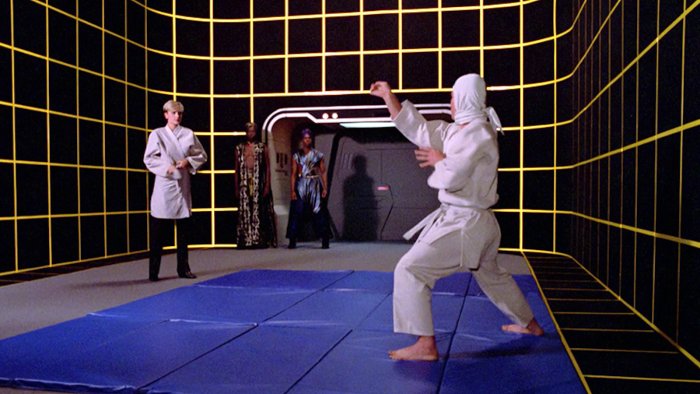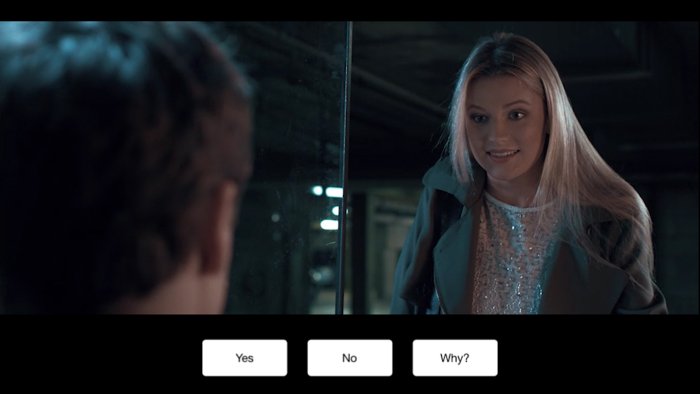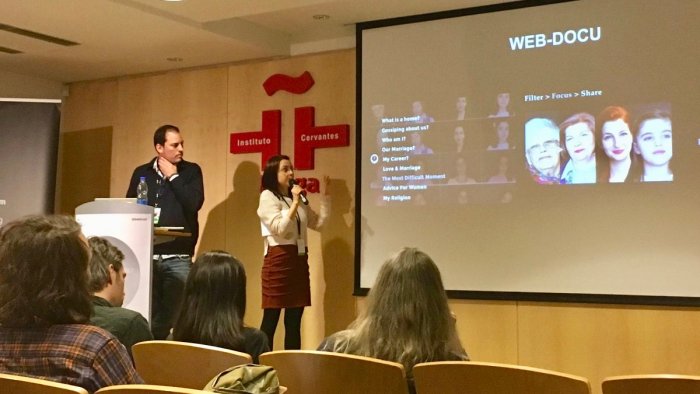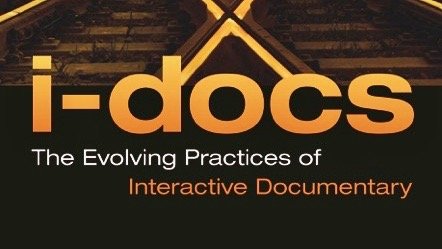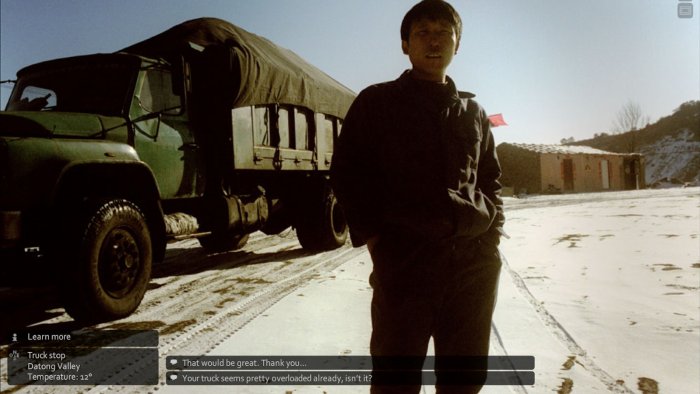Introduction to the Thematic Area | Mattia Lento
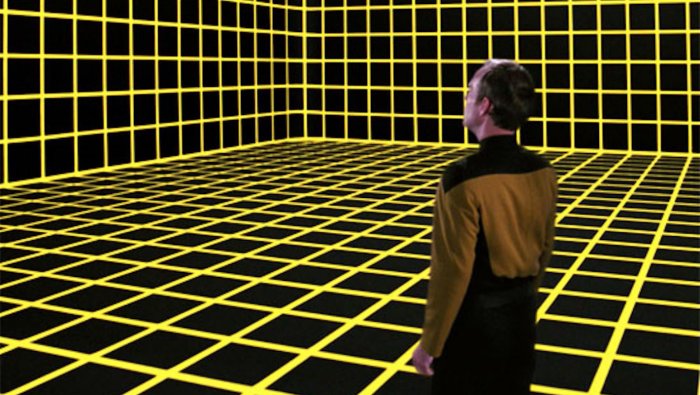
Launch
Space, the final frontier. Captain Picard and Lily Sloane are being hunted by a couple of Cyborgs belonging to the Borg race. A single door separates these two earthlings from the terrible enemies of the Federation of the United Planets. At this point, there is no hope for them, but Picard, using an environmental holographic simulator (a Holodeck, in the original), transforms their surroundings into an exclusive club, typical of gangster movies. This transformation disorientates the two Borgs, who are now trapped at the entrance to the club by a bodyguard, dressed in tuxedo, preventing them from entering the club: it is well known that Cyborgs do not always pay attention to style and elegance. The two Cyborgs manage to get rid of the bodyguard, but Picard, meanwhile transformed into a detective like in one of the "hard-boiled" detective movies, realizes that he has chosen the wrong chapter. The club is half-empty and is about to close. Thanks to a voice-activated request, the simulator throws Picard and Lily into the fortieth chapter and the two characters find themselves in exactly the same place, but that it is now filled with elegantly dressed couples embracing one another while dancing. Thanks to this trick, they manage to camouflage themselves and succeed in neutralizing the two Borgs, eventually enabling them to steal the computer chips from the Borgs, on which there are hidden plans concocted by this species/race to exterminate the earthlings.
The Holodeck is one of the most infamous futuristic inventions in the fictional, cross-medial world of Star Trek (specifically, the movie Star Trek: First Contact). It is a technological device that can recreate hyper-realistic settings with the help of force fields, the reproduction of matter, and advanced techniques for recreating the acoustic environment. The Holodeck is a home entertainment system that allows the user to interact with the virtual diegetic universe and to modify its features. Examining the current media situation, an obvious question arises: have we really reached the Era of the Holodeck that science fiction had foreseen a few decades ago?
Interactive Digital Narratives
Maybe it is still too early to make such statements, but it is true that the great developments in technology, and in the Internet in particular, have set the conditions for the growth of special kinds of media that could be labelled “Interactive Digital Narratives”. It is not easy to define or classify these new forms of expression, characterized by abrupt changes, experimentation and hybridization. It is not easy, partly because, at the University level, these phenomena have only recently been systematically studied and there is still no agreement on the terminology developed in these last years. There have already been some efforts, however, in this relatively complex field, which can help us find our way inside a complicated world, in which moving images and interactions run into each other.
the fields
Scholars have identified three fields, which can subdivide the interactive digital narratives:
- the "textual" field
- the "cinematic-performative" field
- the "recreational-experimental" field
The first is less interesting for us. The second and the third, however, are the ones we want to focus on in this forum, because they directly involve moving images.
the origins
The "origins" of the interactive digital narrative have been traced, respectively, into the three fields mentioned above, as:
1) The interactive and hyper-textual drama (for example, the Choose Your Own Adventure stories that were popular in the Eighties).
2) The interactive movie, beginning with the Czech director Radúz Çinçera, who presented the movie One Man and His World and the “Kinoautomat” at the International Fair in Montreal in 1967: a device that allows the interruption of the projection for the audience to choose the continuation of the story. One recent example of an interactive movie conceived for a movie theatre is the thriller Late Shift (see the article on Filmexplorer). Another good example can be found in multilinear television: the Danish experiment on TV D-Dag in 2000 was of particular historical relevance (realised by the directors Kragh-Jacobsen, Levring, Vinterberg and Von Trier). It consisted of simultaneously broadcasting four different stories on the same subject on four different TV channels.
3) Experiments made using video art, interactive drama, the first video gaming forms (i.e. videogames), which started to become a mass-media at the end of the Seventies, but which began to present real interactive stories with series like King's Quest (1984-), Monkey Island (1990-2010), or single titles like Myst (1993) – continuing the tradition of adventure games based on space exploration and on puzzles solutions, but a game that introduces evocative atmospheres and a visual representation that takes into account the point of view of the player –, or The Last Express (1997), in which the player plays the part of a passenger of the Orient Express struggling with a railway crime at the beginning of the Twentieth century.
Interaction
Interacting is part of our daily life and it is the foundation of any communication among individuals, groups or institutions. Therefore, this subject is at the centre of scientific goals in the fields of sociology, ethnology and pedagogy. Already at the end of the Nineteenth century, the German philosopher Georg Simmel was emphasizing how sociology, a rising discipline at that time, should deal with neither the individual nor the society, but with the complicated net of relationships established by different entities: either by human beings or by more or less developed organizations.
Even in the field of media theory, of course, the topic of interaction is of great interest. When we discuss media, interaction takes on different meanings and becomes more complicated, although it has links to the observations made in sociology and in its sister disciplines. Media researchers study the interactions between people, interactions between people and machines, virtual interactions between users, and even interactions between machines. If we were to use a broader meaning of the definition, interaction relates not only to the new media, but it has become a major and central topic in the theoretical and critical discussion since the emergence of digital media. If it is not wrong to say that each medium presupposes even the slightest degree of interaction, it is also true that «only with the digital technologies and with the connectivity made available through the web, it is possible to speak about a bidirectional flow of information and exchanges between user and medium, so that the first gets transformed from a more or less passive receiver of a content into a co-author of the content itself» – as stated by Sandra Gaudenzi, one of the major interlocutor in our inquiry.
According to Gaudenzi, in philosophical terms, interaction is part of human nature, since «it is the way we perceive the world, the way we understand its meaning, even through the body». Interacting with other beings and with the world is part of our nature, but in the field of media there is an authentic interaction only when it is possible for the user «to modify the output» that comes from the medium itself, which means that it is possible to make major changes at the narrative level, but not only at that level.
For guidance on the general topic of the interaction with moving images through digital media, we interviewed Sandra Gaudenzi, researcher at the University of Westminster, where she founded the Digital and Interactive Storytelling Lab, and co-director of the i-Docs conference and website at the Digital Cultures Research Centre at the University of West England in Bristol:
Sandra Gaudenzi on Interaction
Videogames and Gaming
It is impossible to think of the interaction between human beings and medium without making any reference to videogames. Videogames are definitely the most important interactive medium of our contemporary lives. The player is always taking part in the story and sometimes he can even build the plot of the gaming adventures himself. One could say that the videogame sets a diegetic universe, but the player arranges the plot through his own performance.
In comparison with other interactive media, videogames have received more theoretical attention – partly because they are quite recent – resulting in the growth of an important international academic community. This community has managed to create a specific vocabulary through the coining of categories conceived specifically for the medium. The most important among them it is probably the notion of "ludology," used initially in contrast with narratology.
the difference between ludology and narratology
According to some experts, videogames could, in fact, not be defined as a narrative medium at all, and they should have been analysed only on the basis of the potential interactions between the player and the game. With this statement, besides setting the preconditions for the beginning of an independent discipline, the scholars aimed at emphasizing how interaction had to become the major point around which to organize any debate on videogames. Today, they are questioning the denial of the narrative nature of videogames, but ludology is still by the side of narratology as a fundamental theoretical and analytical instrument in the so called area of "game studies".
Interactive Digital Documentary
About ten years ago, Samuel Bollendorff and Abel Ségrétin created one of the first audio-visual products officially defined as an “interactive documentary”. In Voyage au bout du charbon (Journey to the End of the Coal, 2008), broadcasted back then by the online version of Le Monde, the user is asked to put himself into an investigative reporter's shoes and to start a trip through Chinese coal mines. This interactive documentary (or i-Doc) tells the story of hundreds of thousands Chinese miners who risk their lives to earn some money to barely survive, through pictures, short videos, and sound bites. The user has to make decisions as to which path to take, which questions to ask, and the actions to be taken; always with a limited range of available choices (go to the i-Doc).
In 2008, the web was not offering the same possibilities that we enjoy today, so it should not be surprising for the modern user if the degree of interactivity of Journey to the End of the Coal does not seem particularly high. The product is, however, more than acceptable and it lets us observe some important elements of the interactive documentary. First of all, it allows us to define the "genre": it is called "interactive digital documentary" not simply because it is widespread through the Internet or because it employs the opportunities offered by the current digital technologies, but especially because it documents a situation in an interactive way. It demands that the user become a partner and, although within specific limitations, to become a creator, together with the author of the documentarist narration. Additionally, its own interactive nature makes it significantly different from the classic documentary, whose narration, independently from its degree of complexity, should be considered basically as "linear": in an interactive documentary, the narration progresses with jumps, cuts, returning themes, interruptions, afterthoughts. Both of the typologies of audio-visual texts are born with the wish to document a situation, but their basic grammar is very different. The interactive documentary is indeed more open to experimentation and to a hybridization of languages that cannot be paralleled.
Furthermore, Journey to the End of the Coal can be considered like an embryonic form of "immersive journalism", which is a type of journalism that allows the audience to live first-hand unique events and situations, that are generally rarely accessible. Even in the latter case, the degree of “immersivity” is not very high, but we are not far from the attitude or aims of products that use special technologies like the 3D or virtual reality to simulate an unparalleled feeling of displacement in the user.
Contributors
In order to discuss such a complex topic as the relationship between interaction, reception, and moving images, it was necessary to make choices and to remove some issues and aspects that were quite relevant nonetheless. We are aware of having favoured, for example, an interactive device in which the user is often in a sedentary position and, except for the options of connectivity given by the web, she/he is alone in front of the medium, or at least in a private dimension. Therefore, we have put aside even the interactive devices typically used in video installations and in the exhibitions of moving images, although we have not underestimated their importance (see the thematic area on "The Hybridization between the Black Box and the White Cube").
Additionally, we decided to give priority to the "documentary genre" more than to fiction, because it looked like a testing ground in great turmoil, at least in some particular contexts, such as in North America. Besides, fiction was indirectly taken into account when we talked about videogames. The documentary allowed us to talk about the relationship between interaction and narration, but it also gave us the opportunity to focus on the relationship between reality and the direct involvement of the audience in its representation or, better, in its "construction"; something that would not be possible with the traditional fiction.
First, we consulted Sandra Gaudenzi, a world-renowned researcher. She talks about interaction not exclusively from a philosophical, phenomenological and theoretical perspective – as we have examined already in this introduction –, but she also introduced us to her field of expertise, i.e. the interactive digital documentary. Gaudenzi came up with a definition of this new form of expression and gave us some basic hints regarding the appropriate terminology, but primarily, she discussed the relationship between the i-Doc and videogames, between the i-Doc and journalism and, in particular, she talked about the political-moral repercussions of the interaction and, last but not least, she tried to classify the different typologies of the interactive documentary through what she calls the "modes of interaction".
Three successful professionals, active in the creative and productive field (Lili Blumers, Federico Dini, and Jiannis Sotiropoulos) were able to provide important information related to the jobs revolving around interactive digital narrations and, in particular, around the documentary. What are the professions mostly active in the sector? What kinds of skills are required? What are the differences between a traditional, linear product and a project based on interactivity? What kind of relationship do they intend to establish with the audience?
Along with them, we also interviewed Jean-Pierre Candeloro, responsible for the Interactive Documentary Workshop, and who frequently attended the festival Visions du Réel in Nyon. He is a personality that has acted like a bridge between theoretical analysis and practice, and he is someone who could offer a point of view on the state of interactive documentary in Switzerland, on its current problems, and on the future perspectives of development.
The analysis on the interactive digital documentary did not prevent us from following-up, together with Marco Pagani, even on the videogames. The Retedue (RSI) Radio journalist, an expert in this field and in gambling, spoke with us about the historical evolution of videogames, about the great power of this industry, about the problems that it faces in some "well-educated" environments, the relationships between videogames and cinema, the different types of games, and, in particular, he managed to communicate to us his impressive ludic passion.
Enjoy your listening and your interaction!
Short Bibliography
AA.VV., Interactive Digital Narrative. History, Theory and Practice, Routledge, New York 2015.
J. Aston - S. Gaudenzi - M. Rose (eds.), I-Docs: The Evolving Practices of Interactive Documentary, Wallflower Press, London-New York 2017.
J. Bolter – R. Grusin, Remediation. Understanding New Media, MIT Press, Cambridge 1999.
A. Bryan, The New Digital Storytelling. Creating Narratives with New Media, Praeger, Santa Barbara-Denver-Oxford 2011.
N. Carpenter, Media and Participation: A Site of Ideological-Democratic Struggle, Intellect, Bristol-Chicago 2011.
L. Manovich, The Language of New Media, MIT Press, Cambridge 2001.
J. Murray, Hamlet on the Holodeck: The Future of Narrative in Cyberspace, The Free Press, New York 1997.
S. Gaudenzi, The Living Documentary: From Representing Reality to Co-creating Reality in Digital Interactive Documentary. Doctoral thesis submitted at Goldsmiths (Centre for Cultural Studies), University of London, 2013. See the thesis here.
K. Nash - C. High - C. Summerhayes (eds.), New Documentary. Ecologies, Emerging Platforms, Practices and Discourses, Palgrave Macmillan, London 2014.
M. Rieser - A. Zapp (eds.), New Screen Media. Cinema/Art/Narrative, BFI Publishing, London 2002.
B. Weiberg, Beyond Interactive Cinema, 2012. Read the article here.
M.J.P. Wolf - B. Perron (eds.), The Routledge Companion to Game Studies, Routledge, New York 2014.
